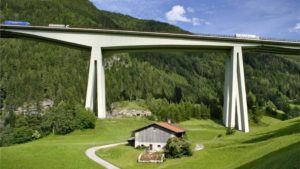Kategori : ENERGY AGENDA NEWS, ENERGY EFFICIENCY NEWS - Tarih : 02 January 2019
Concrete is the most widely used man-made material in existence. It is second only to water as the most-consumed resource on the planet.
But, while cement – the key ingredient in concrete – has shaped much of our built environment, it also has a massive carbon footprint.
Cement is the source of about 8% of the world’s carbon dioxide (CO2) emissions, according to think tank  Chatham House.
Chatham House.
If the cement industry were a country, it would be the third largest emitter in the world – behind China and the US. It contributes more CO2 than aviation fuel (2.5%) and is not far behind the global agriculture business (12%).
Cement industry leaders were in Poland for the UN’s climate change conference – COP24 – to discuss ways of meeting the requirements of the Paris Agreement on climate change. To do this, annual emissions from cement will need to fall by at least 16% by 2030.
So, how did our love of concrete end up endangering the planet? And what can we do about it?
In praise of concrete
As the key building material of most tower blocks, car parks, bridges and dams, concrete has, for the haters, enabled the construction of some of the world’s worst architectural eyesores.
In the UK, it helped the massive wave of post-World War Two development – much of it still dividing opinion – with several of the country’s major cities, such as Birmingham, Coventry, Hull and Portsmouth, largely defined by the concrete structures from that building push.
But concrete is also the reason some of the world’s most impressive buildings exist.
Sydney Opera House, the Lotus Temple in Delhi, the Burj Khalifa in Dubai as well as the magnificent Pantheon in Rome – boasting the largest unsupported concrete dome in the world – all owe their form to the material.
In 2016, world cement production generated around 2.2 billion tonnes of CO2 – equivalent to 8% of the global total. More than half of that came from the calcination process.
Together with thermal combustion, 90% of the sector’s emissions could be attributed to the production of clinker.
Because of this, Mr Preston and his colleagues argue the sector urgently needs to pursue a number of CO2 reduction strategies.
Further efforts on energy efficiency, a move away from fossil fuels and pursuing carbon capture and storage will help, but can only do so much.
“We’ve got a long way to close the gap,” Mr Preston says.
What the industry really needs to do is plough efforts into producing new types of cement, he argues. In fact, low-carbon cements and “novel cements” might do away with the need for clinker altogether.
New cements
One of those trying to drum up greater support for such alternative cements is Ginger Krieg Dosier, co-founder and CEO of BioMason – a start-up in North Carolina that uses trillions of bacteria to grow bio-concrete bricks.
The technique, which involves placing sand in moulds and injecting it with microorganisms, initiates a process similar to the one that creates coral.
“I have a long fascination with marine cements and structures,” explains Ms Krieg Dosier, a trained architect who was surprised to find no real green alternatives to bricks and masonry when she began research at an architectural firm more than 10 years ago.
The discovery led her to create her own solution, which, after years of development, now takes only four days. It happens at room temperature, without the need for fossil fuels or calcination – two of the main sources of the cement industry’s CO2 emissions.
Ms Krieg Dosier believes green cements and technologies such as hers offer a solution to the sector’s emissions issue.
“Traditional Portland-based cement production practices will continue to release CO2 due to its fundamental chemistry,” she says, adding that rather than turning to carbon capture and storage, we should be investing more in techniques that actively remove carbon from the atmosphere.
“Alternative cements and binding technologies go beyond evolutionary CO2 capture to revolutionary methods that fundamentally sequester CO2.”
‘Disruptive forces’
Alongside such alternative cements, other “disruptive” forces are also beginning to drive change. Digitalisation, machine learning and an increasing awareness of sustainability are all having an impact on the cement industry’s culture.
“It’s partly changing because of how people want to live, but also because of our ability to dream up new and innovative structures and test those with computer models,” says Mr Preston. “There’s also the ability to build things more cheaply with robots – with automation.”
But changing processes quickly enough to meet the cement industry’s obligations will be a challenge.





